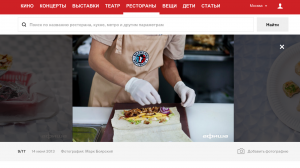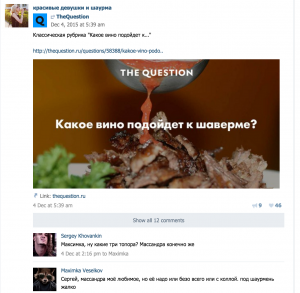Andrew Chapman, The College of William and Mary
In June of 2015, social media promoters Roma Bordunov and Aleksei Novikov launched the VK.com group “Beautiful Girls and Shawarma” (https://vk.com/donergirls). The webpage features women, posing (often provocatively) with one of Russia’s beloved street food snacks. The site immediately gained in popularity, with hundreds of uploaded photos and over 11,000 members in less than a month. Upholding the shawarma spit, “with the support” of the Russian Federation, the page celebrates Russia’s street food tradition.
Posing with shawarma
Source: https://vk.com/donergirls
The group’s popularity recalls numerous discussions and developments within the recent politics of Russia’s food industry. Their site mimics government language citing that the group has been opened with “With Support from the Ministry of Healthcare of the Russian Federation” (“Krasivye devushki i shaurma: Pri podderzhke ministerstva zdravookhraneniia RF”). One British online publication, Express, took the parody quite literally, when they wrote that “Beautiful Girls and Shawarma” is a campaign directly from Putin’s government.
The site also plays with controversies over the nationalization of fast food in Russia, which has undergone transformations in the past year. Most notably, the Russian state’s attack on western fast food companies such as McDonalds showed that Russia was ready to dump the chain, despite it being a staple of everyday dining since the first queues appeared outside of the first Moscow McDonalds in the winter of 1990.[1] At the same time, the state has been unsuccessfully promoting its own newly funded national chains, such as “We Eat at Home” (Edim Doma”), while the stalwarts of Russian fast food, such as Teremok, are professionalizing their service practices in order to keep up with the Whopper and Big Mac. Paralleling this movement, the Russian state has sought to minimize small kiosks throughout Moscow, at times aggressively targeting the ethnic food staple – the shawarma. The health inspection agency ROSKOM closed down numerous vendors, echoing past threats to close down the majority of shawarma selling kiosks in the mid 2000s under the claim that these stands were covered in fecal matter.[2]
While the cold war of fast food chains and ethnic cleansing of kiosks heated up in the summer of 2015, I am more interested in how citizens of the Russian Federation cultivate both culinary taste and middle class taste vis-à-vis fast food chains and street food vendors. Russians’ frequenting to fast food chains has always been a sign of affluence since the 1990s, and with Russia’s growth in wealth over the past decade, it is apparent that chains are becoming more luxurious in order to suit their clientele.
The once cheap meal o the shawarma can also give us useful insight into Russia’s middle class. “Beautiful Girls and Shawarma” is yet another example of the middle class and its preoccupation with digital self-representation. People taking selfies with shawarma shows us how digital media has become central to the middle class experience, extending well into unglamorous moments of everyday life in order to present it beautifully and in digitally filtered “Instagram” color. This moment gives us a historical picture, as it meshes the past of the dingy 1990s kiosk street meat, with the trendy digital creativity of the late 2000s and present day.
Russian citizens’ current attitude to street food is also emblematic of a larger trend in hipster gentrification. Today, many kiosks are giving way to more upscale branded shawarma cafés, which offer a clean eating environment and supposedly better chance against food poisoning. On the site TripAdvisor, one user comments on the advantage of the café in their revue of Shawarma Republic, writing “This is the place where you can eat a tasty shawarma without any worries [of quality].”
The Question: Which wine pairs well with shawarma?
Source: https://vk.com/donergirls
Russia’s hipster gentrification of food culture encroaches upon lower class urban spaces, directly mirroring what has happened in the United States. In the last ten years in the US, the working class construction-site food truck vendor, which largely originated from Latin American roots, transformed into entrepreneurial, social networking hipsters who now serve blue collar workers haut cuisine. Russia’s once “unsanitary” street food options are being given facelifts, expanding the once barren shawarma menu to include cheese-infused lavash bread and vegetarian alternatives. People once joked about the source of shawarma meat, remarking that despite Moscow’s large stray cat population, there were never any around the kiosks themselves. Now, thanks to evolving high-class tastes, your shawarma might not even come with meat inside of it.
June 2015
[1] In August of 2014, the health industry shut down McDonalds in Moscow over sanitation violations, in retaliation for the American chain’s stance on closing its own stores in recently annexed Crimea.
[2] Kiosks serving traditional Russian food such as Teremok and Kroshka-Kartoshka were not targeted.



